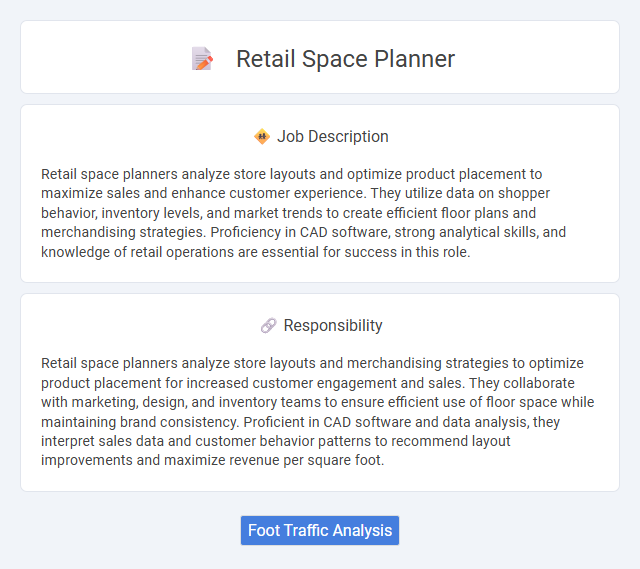
Retail space planners analyze store layouts and optimize product placement to maximize sales and enhance customer experience. They utilize data on shopper behavior, inventory levels, and market trends to create efficient floor plans and merchandising strategies. Proficiency in CAD software, strong analytical skills, and knowledge of retail operations are essential for success in this role.
Individuals with strong analytical skills and an eye for detail likely find retail space planner roles suitable due to the need to optimize store layouts for customer flow and sales. Those comfortable working in dynamic environments and collaborating with marketing, sales, and design teams probably adapt well to the demands of this job. People who struggle with spatial reasoning or prefer more isolated work settings may not find this role as fitting.
Qualification
A Retail Space Planner requires strong skills in data analysis, visual merchandising, and CAD software proficiency to design efficient store layouts that maximize sales and improve customer experience. A background in retail management, architecture, or interior design with a bachelor's degree is often essential, alongside knowledge of inventory management and market trends. Expertise in spatial planning, attention to detail, and the ability to collaborate with marketing and operations teams are critical qualifications for success.
Responsibility
Retail space planners analyze store layouts and merchandising strategies to optimize product placement for increased customer engagement and sales. They collaborate with marketing, design, and inventory teams to ensure efficient use of floor space while maintaining brand consistency. Proficient in CAD software and data analysis, they interpret sales data and customer behavior patterns to recommend layout improvements and maximize revenue per square foot.
Benefit
A Retail Space Planner likely enhances store layouts to maximize product visibility and customer flow, increasing sales potential. This role may improve inventory management efficiency, reducing costs associated with overstock and understock situations. Optimized retail spaces could contribute to an elevated shopping experience, fostering customer satisfaction and loyalty.
Challenge
Retail space planner roles likely involve the challenge of balancing aesthetic appeal with functional layout to maximize sales potential. They must probably anticipate consumer behavior patterns and adapt store designs accordingly, which can be complex in fluctuating market conditions. Managing tight deadlines and coordinating with multiple teams could also present ongoing difficulties.
Career Advancement
Retail space planners leverage data analytics and consumer behavior insights to design effective store layouts that maximize sales and enhance customer experience. Mastery in 3D modeling software and strong collaboration with merchandising and marketing teams can accelerate career progression to senior planner or retail operations manager roles. Continuous learning in emerging technologies and retail trends drives advancement opportunities within large retail chains or consultancy firms.
Key Terms
Foot Traffic Analysis
Retail space planners specializing in foot traffic analysis utilize data-driven techniques to assess customer movement patterns and optimize store layouts for maximum engagement. They employ tools such as heat maps, sensor data, and video analytics to identify high-traffic zones, enhancing product placement and in-store navigation. This strategic approach increases conversion rates and overall sales by aligning retail environments with natural customer behaviors.
 kuljobs.com
kuljobs.com